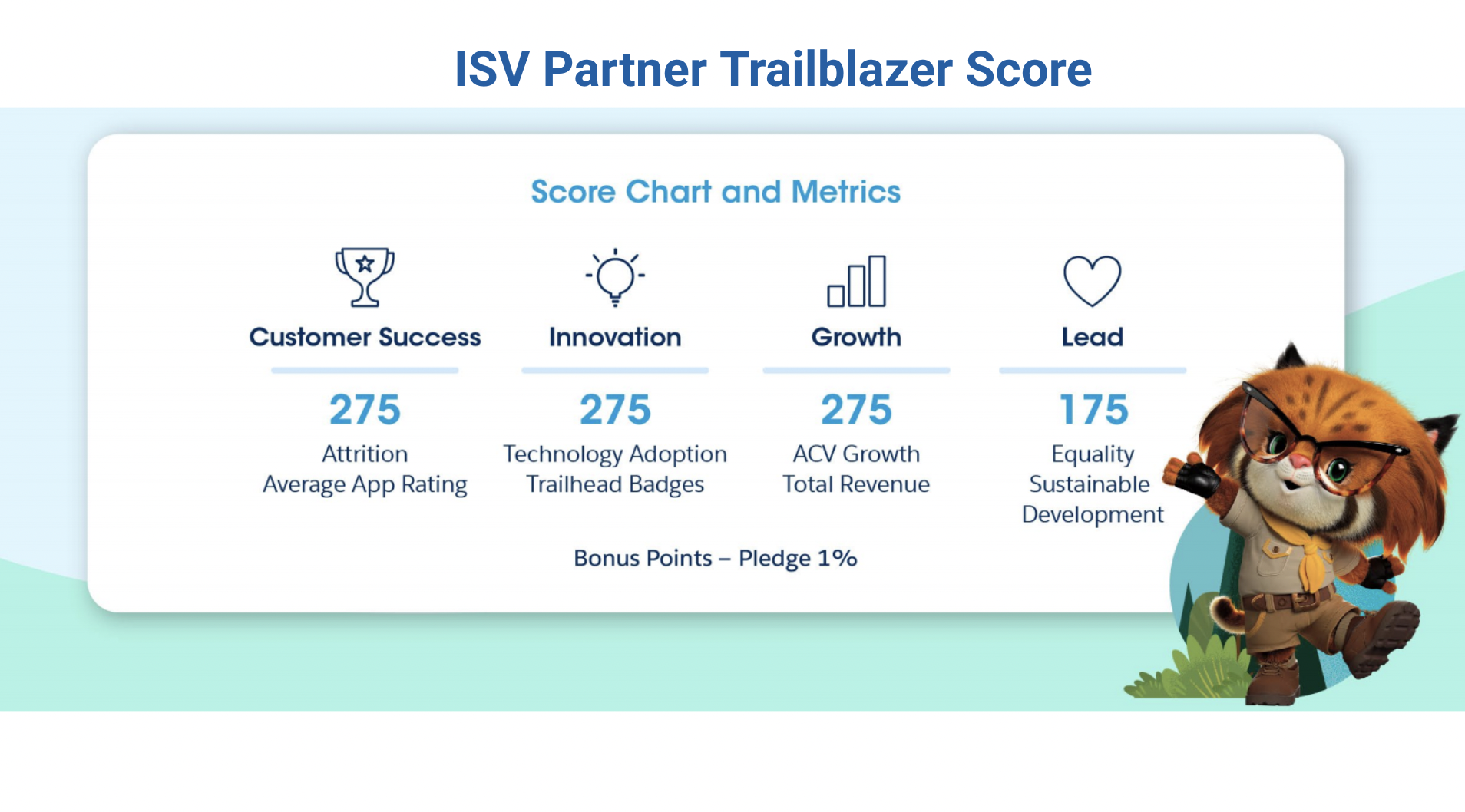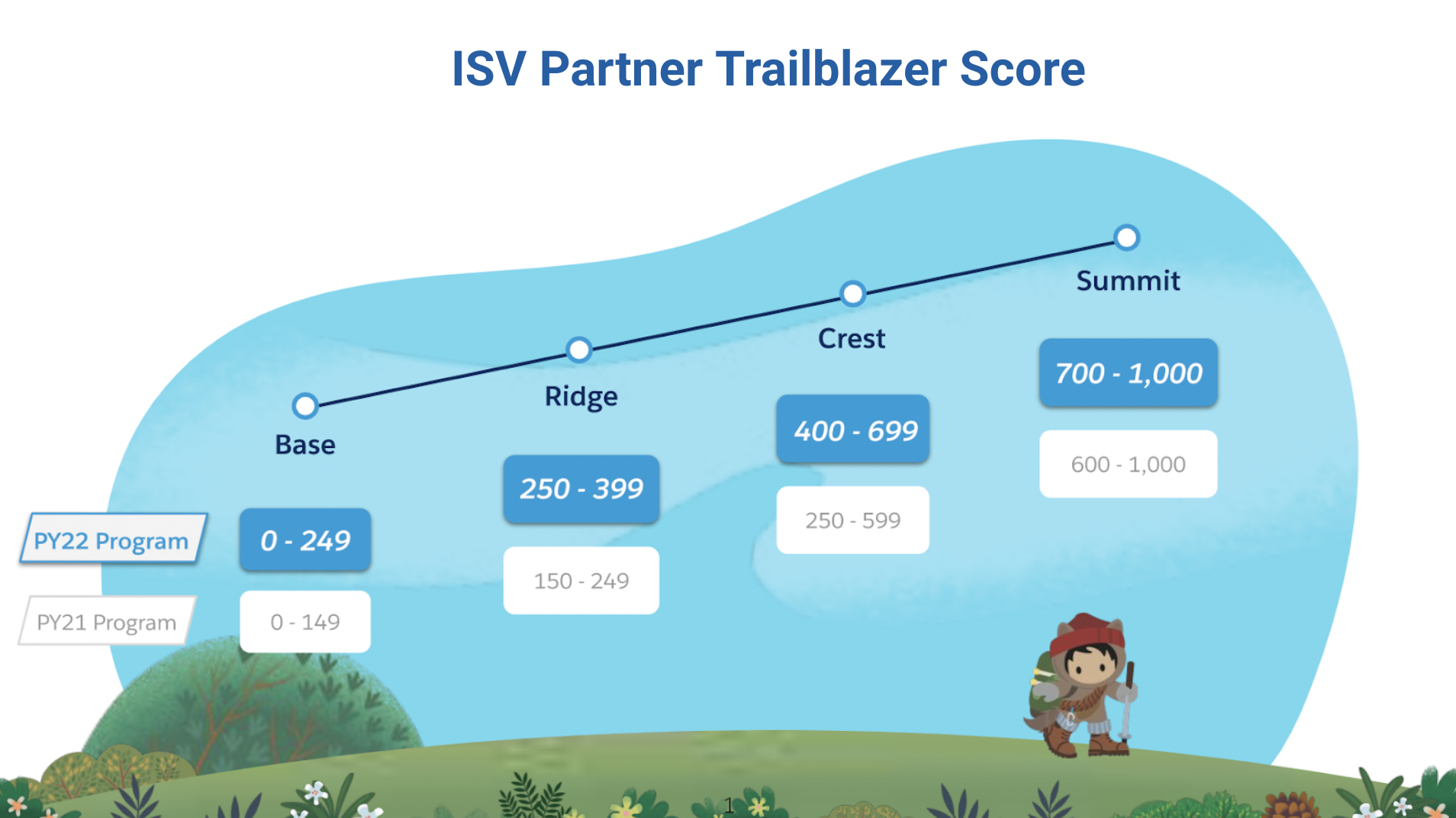ISV Partner Tiers in Salesforce—Low Hanging Fruit to Get Points & Climb the ISV Mountain
Before you read this article, find your current tier and point total, search your email for “AppExchange Trailblazer Score”.
In FY21 (2020), Salesforce rolled out a new model for ISVs to access benefits which retired the concept of precious metals for a more Trailhead-themed approach that expands the focus beyond just revenue performance. The tiers for the ISV Partner Program, in order, are Base, Ridge, Crest, and Summit.
Revenue remains the most important lever to get you more points as an ISV, but Salesforce made this change to increase access to smaller partners who are investing in things like leveraging Salesforce technology, encouraging their employees to earn Trailhead badges, doing the 1% Pledge, and having a steady stream of great reviews on the AppExchange. Moving from Crest to Summit will require significant revenue performance, but every ISV can easily get to Ridge if they have at least a handful of successful customers and at least four employees.
The tiers are determined by a scale from 0 to 1000, and each tier unlocks additional partner benefits. A full breakdown is on page 9 of this document in the partner community, but here are some highlights I believe have an ROI for investing energy into this.
Go-to-market with Salesforce as an ISV
-
Assignment to more senior PAMs which have fewer ISVs in their territory. This is unlikely to change mid-year but rather when Salesforce changes territories in their new FY. PAMs can be massive force multipliers facilitating introductions to AEs, SEs, CSMs, and Product Leadership at Salesforce, and they will naturally gravitate towards the partners who they trust will do a great job and grow PNR. Your success is their success.
-
Access to AppExchange Marketing Programs (AMP). This is available to Ridge and above, and I can tell you from experience that leads from these have significant higher close rates. It is pay-to-play, but depending on your business, it can drive meaningful ROI.
-
Industry Blueprint & Roadmap Webinars. This is available, up to two per year, for Crest and Summit. If you are unfamiliar, Salesforce compiles these industry blueprints to show the needs of their customers in their key industries and often have multiple within each industry, i.e. Commercial Banking and Wealth Management, in FINS. They include whitespace they actively seek partners to fill when their product set doesn’t meet requirements and will help you in your messaging for AEs/SEs/CSMs.
Salesforce technology for ISVs
-
ISV Developer Tools (Scratch Orgs). Every ISV gets 40, but each tier includes access to more to help your product development lifecycle.
-
Access to Salesforce Customer 360 Platform Experts. These are available, five per year, for Ridge and above. They’re technical consultations with Salesforce team experts on things like Lightning Web Components, Industry Clouds, Architecture, and more.
-
ISV Technical Evangelist (TE) consultations. These are available, three per year, for Crest and above. They are two-hour sessions where you can share your roadmap and any issues your team is facing to get recommendations on how best to leverage the platform.
The tiers are evaluated quarterly throughout the year. You can move up during a FY, but Salesforce prevents you from moving to a lower tier during a given year—which is pretty nice of them.

Okay, I’ll get to the good stuff now. Here is some of the low-hanging fruit to help you move from Base to Ridge or Ridge to Crest next quarter:
-
75 Points—Trailhead badges. If your company total trailhead badges linked to your company (this part is important!) is 600 or more, you get 75 points. Boom! To see the instructions on how to link your Trailhead account, see the “Need to Know” tab or visit p.force.com/trailhead.
Idea to make it happen: Make it a SPIFF for everyone at your company to become a Ranger, which requires 100 badges. -
75 Points—AppExchange Reviews. If your average reviews are 4.6 or above, you get the points. The only caveat is that you need at least five from last FY + this FY, so keep those reviews coming.
Idea to make it happen: Someone asks for a discount? Trade it for a review. -
200 Points—Technology Adoption. This is based on a quarterly assessment that Salesforce sends out. Make sure you fill it out so everything your product team has adopted gets credited to your points. There is a chart in the Innovation section which lists them all, but there are some really basic ones that every ISV worth their salt uses, like Reports & Dashboards, Push Upgrades, Integration to Sales/Service Cloud, the use of Process Builder, etc.
That’s it! Every single partner with at least four employees and five customers should be Ridge, and Crest is pretty simple, too! If you want to drill into this in more detail, reach out to us by booking a call.
UPDATED: 2024 ISV Partner Tiers in Salesforce
In July 2024, Salesforce has updated their Partner Tiers and have removed the Trailblazer Score.
- Registered ISVs (tier 5): joined the AppExchange ISV Program but have not yet established a commercial relationship with Salesforce.
- Exploration ISVs (tier 4): actively involved in commercial conversations with Salesforce for their first paid app.
- Build ISVs (tier 3): completed commercial discussions with Salesforce (with a signed distribution agreement).
- Select ISVs (tier 2): have listed paid application(s) on the AppExchange and are actively distributing to customers.
- Summit ISVs (tier 1): Salesforce’s largest and most strategic ISV partnerships.
Alex Bariyev, SVP of Strategy and Partnerships at Acquiva Labs, wrote an analysis in a blog post on LinkedIn.
